CE-可用性工程评估报告(EN 62366)
- 格式:doc
- 大小:142.00 KB
- 文档页数:10
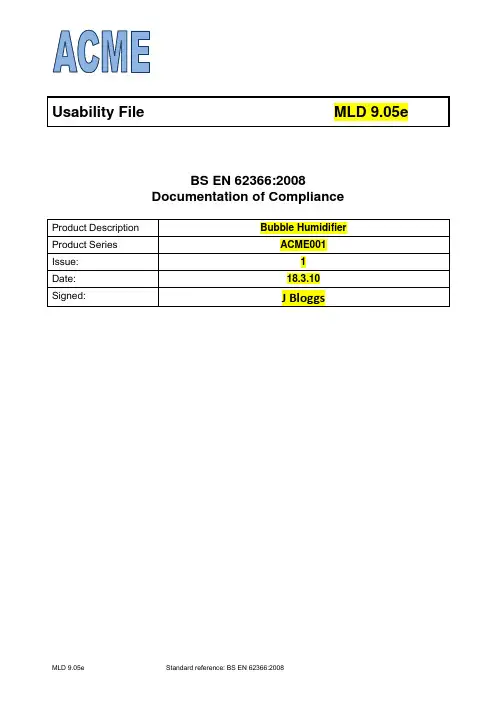
Usability File MLD 9.05eBS EN 62366:2008Documentation of Compliance1 Inputs to the USABILITY SPECIFICATION1.1 Specification of the INTENDED USE/INTENDED PURPOSE1.1.1 DescriptionThe ACME Bubble Humidifier has been design specifically to be used with Oxygen. The unit can be used in most types of medical environments such as Hospital, Medical Centres, Ambulances and Domestic purposes.The humidifier works by conducting gas down the small internal tube that is submerged in water.The gas passes through the diffuser (sintered metal), which breaks the gas into small bubbles,increasing the surface area. The bubbles float passively to the surface, absorbing water vapour.The humidified gas then flows out through the outlet. The bottle component is moulded inautoclavable HDPE.The Humidifier has been designed to connect to Flowmetering Devices via a 9/16 Connector and that can provide a flow rates from 2 to 6 Lpm with a backpressure of 4 bar.1.1.2 EQUIPMENT application specification1.1.2.1 Medical purposeTo humidify the medical gas flow (Oxygen) to a patient e.g. via attached tubing and facemask.1.1.2.2 PATIENT populationa) Age: newborn to geriatricb) Weight: > 2.5 kgc) Health: not relevantd) Nationality: multiplee) PATIENT state:- PATIENT is not the OPERATOR1.1.2.3 Part of body or type of tissue applied to or interacted withNo direct contact with the patient – though attached tubing and facemask would contact noseand mouth.1.1.2.4 Intended OPERATORTrained medical or paramedical staff who understand how to connect to a flowmeter and the use of humidified oxygen.1.1.2.5 Applicationa) EnvironmentGeneral:- Hospital- Care Home/Hospice- Ambulance- Could be damaged by impact e.g. dropping or collision, then not function.- When functioning is shall keep humidifying the oxygen..Conditions of visibility:- Ambient luminance 100 – 500 lux- Viewing distance 20 cm to 1 metre- Viewing angle: normal to the scale ± 20°Physical:- Working pressure 400 kPa- Operation range 2 to 6 Lpm recommended- Permitted leakage - zero- Normal ambient conditions apply.b) Frequency of use:- Once a year up to 10+ times a dayc) Mobility:- Intended to be fixed to gas supply, which could be on a mobile trolley.1.2 PRIMARY OPERATING FUNCTION1.2.1 Frequently used functionsa) Filling with waterb) Reading scalec) Attaching to/removing from gas supply/flowmeterd) Attaching to patient tubing/facemask.e) Cleaning – can be sterilisedf) Storing1.2.2 Functions related to SAFETYa) Reading scale – especially when water supply exhaustedb) Supplying correct flow for condition/patientc) Cleaningd) Servicing & maintenance1.3 Risk analysis1.3.1 INTENDED USE/INTENDED PURPOSESee 1.11.3.2 USER PROFILESee 1.1.2.41.3.3 Things That could go wrongSources: Literature, Device Alerts, Sales, Healthcare Staff, Risk Analysis etca) During normal use:- Water has run out → level not visibleb) Use Errors:- Not refilling- Applying excessive force/mechanical stress/tampering- Dropping/Impact- Blockage- Leakagec) Environment:- Explosion when exposed to ignition sourced) Patient:- Tamperinge) Reading:- Not reading water level correctlyf) Hygiene:- Cross-contamination1.3.4 Task requirementsa) Clearly recognisable instructions on bottleb) Easily assembled/disassembledc) Readable/legible scaled) Easy cleaning of devicee) Light-weight designf) Easy to service & maintain1.3.5 The context of useSee 1.1.2.51.3.6 Information on HAZARDS known for existing deviceIncluded in 1.3.31.3.7 Resulting HAZARDOUS SITUATIONS and HARMSa) No humidification → improper treatmentb) Too much O2 administered over time – i.e. no CO2 content for breathing responsec) Ineffective therapy e.g. for COPD if Air rather than O2 administered/Hypoxiad) Introducing contaminants to the bodye) Used with patients whose supraglottic airways have been bypassed1.3.8 Preliminary review of the USER INTERFACE conceptNote: This review could be conducted utilizing a combination of cognitive walkthroughs, mock-up testing and early prototype testing.a) Connection into appropriate oxygen flowmeter:- Flowmeters labelled & body/knob colour coded (black – AIR; White – Oxygen) Conclusion: No issuesb) Connecting patient tubing/face mask from flowmeter:- Could supply Air to patient rather than Oxygen or vice versa- Operating outside recommended flow rateConclusion: Training issuec) Preparing use:- Easy to assemble/disassemble- Filling to maximum level with water- Detailed operating function in instructionsConclusion: no issuesd) Reading display:- Font and lines clearly legible- Instructions on bottle)Conclusion: no issuese) Cleaning:- Can be autoclaved- Easy visual identification of contaminated surfaces- Surface finishes smoothConclusion: no issuesf) Removing from gas source/flowmeter- Requires unscrewing from flowmeter- Straight forward procedureConclusion: no issues2 USABILITY SPECIFICATION2.1 Generala) MEDICAL DEVICEBubble Humidifier – H110b) Basis:- Intended use, see 1.1- Possible use errors, see 1.3.3- Hazardous situations or harms related to use, see 1.3.7- Context of useo Patient attaches/un-attaches facemask connected to gas source –flowmeter/humidifier assembly- Preliminary use scenarioso Patient searches for facemask/tubing connected to flowmeter/humidifierassembly by bed Terminal Unit (TU)o Operates attached flowmeter independently2.2 USE SCENARIOSWorst case scenarios to provide a basis for validation with patient = usera) Breathing humidified oxygen in bed:- user/patient = adult- alone in room, not supervised- lying in bed or in chair by bed- operates flowmeter control knob- breathes through attached facemask/tubing- pulls out nasal cannula- ignition source/materials- allows water to run out2.3 USER actions related to PRIMARY OPERATING FUNCTIONSa) Turning attached flowmeter on/offb) Placing connected facemask correctly over nose/mouth or cannula in nosec) Observes water level – reading resultd) Cleaning device after usee) Arranging servicing as necessary (PPM)f) Removing device from gas source/flowmeterg) Storing device correctly when removed (stores/EBME)2.4 USER INTERFACE requirements for the PRIMARY OPERATING FUNCTIONSa) Connection to gas source/flowmeter:- easy connection to flowmeter with one hand- indication on bottle instructions (label) not to use with patients whose supraglottic airways have been bypassedb) Filling with water- easy to fillc) Reading display:- scale and bobbin clearly visible under conditions of visibility, see 1.1.2.5- minimum and maximum level indicated- text on bottle for correct flow rated) Surface and material:- body impact strength 80 kJ/m2 (Notched Charpy)- smooth surfaces for easy cleaninge) Holding part:- bottle height 104mm- bottle width 76mmf) Measuring part:- smooth translucent surface – water level easily visibleg) Cleaning:- can be autoclaved- smooth surfaces for easy accessh) Storage:- should be kept in clean plastic bag (as supplied)i) Accompanying Document – issues to be addressed:- no leakage allowed- no grease or oil to be used- not to be exposed to naked flames or radiant heat source- fill with water to maximum level before connecting to gas supply/flowmeter- do not use if damaged- always carry out Inspection prior to use2.5 USER INTERFACE requirements for those USE SCENARIOS that are most frequent orrelated to SAFETYa) The whole setting and measurement procedure shall be easy to do after reading theaccompanying document- connecting to flowmeter- filling to correct level- reading water level scale- setting attached flowmeter to correct flow rate- cleaning the device after useb) Text: Englishc) Font size 8 pt Arial minimumd) Symbols to be intuitive for intended users2.6 Requirements for determining whether PRIMARY OPERATING FUNCTIONS are easilyrecognisable by USERa) Placing device in correct flowmeter:- no additional requirementsb) Filling:- easy to see scale/levelc) Reading scale:- no additional requirementsd) Cleaning:- no additional requirementse) Turning off:- no additional requirementsf) Removing device from gas source/flowmeter- no additional requirementsg) Storing:- no additional requirements。
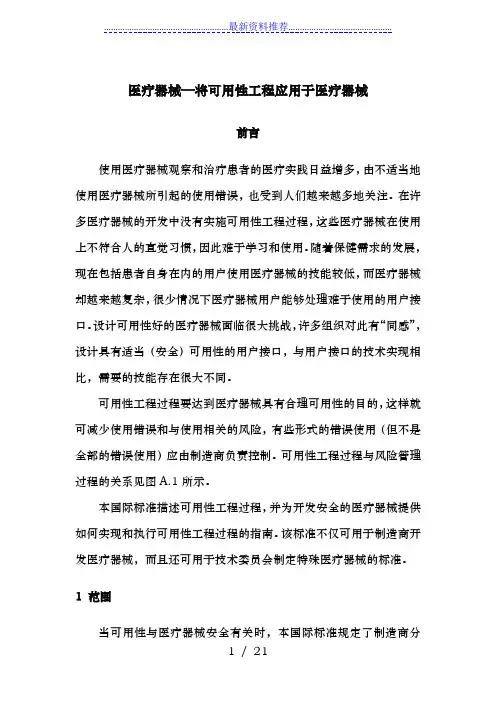
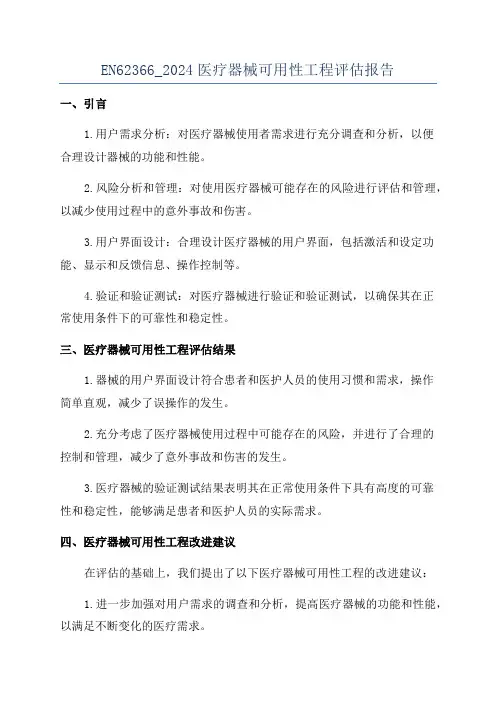
EN62366_2024医疗器械可用性工程评估报告一、引言1.用户需求分析:对医疗器械使用者需求进行充分调查和分析,以便合理设计器械的功能和性能。
2.风险分析和管理:对使用医疗器械可能存在的风险进行评估和管理,以减少使用过程中的意外事故和伤害。
3.用户界面设计:合理设计医疗器械的用户界面,包括激活和设定功能、显示和反馈信息、操作控制等。
4.验证和验证测试:对医疗器械进行验证和验证测试,以确保其在正常使用条件下的可靠性和稳定性。
三、医疗器械可用性工程评估结果1.器械的用户界面设计符合患者和医护人员的使用习惯和需求,操作简单直观,减少了误操作的发生。
2.充分考虑了医疗器械使用过程中可能存在的风险,并进行了合理的控制和管理,减少了意外事故和伤害的发生。
3.医疗器械的验证测试结果表明其在正常使用条件下具有高度的可靠性和稳定性,能够满足患者和医护人员的实际需求。
四、医疗器械可用性工程改进建议在评估的基础上,我们提出了以下医疗器械可用性工程的改进建议:1.进一步加强对用户需求的调查和分析,提高医疗器械的功能和性能,以满足不断变化的医疗需求。
2.增加对使用过程中的风险的评估和管理,及时采取措施,降低意外事故发生的概率。
3.不断优化医疗器械的用户界面设计,简化操作步骤,提高用户的满意度和使用效率。
4.加强医疗器械的验证和验证测试工作,不断优化产品的可靠性和稳定性,提高整体质量水平。
五、结论通过对医疗器械的可用性进行工程评估,我们得出结论:该器械在设计和使用上充分考虑了患者和医护人员的需求,具有较高的安全性和可靠性。
同时,我们也提出了改进建议,以进一步提升医疗器械的功能和性能。
希望本报告能为医疗器械的设计和改进提供参考。
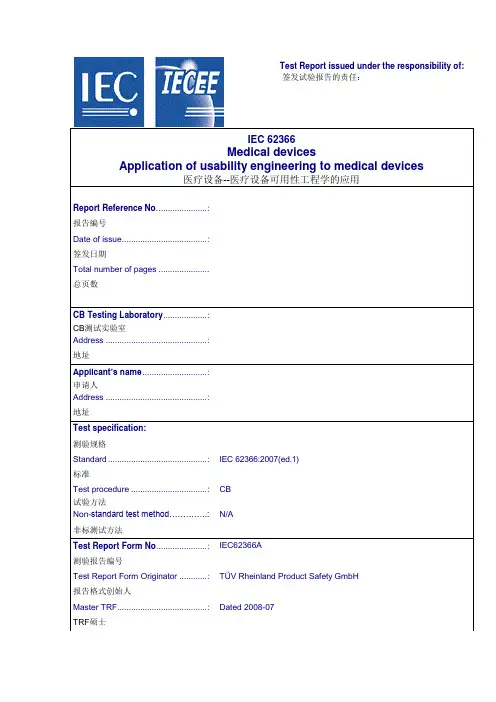
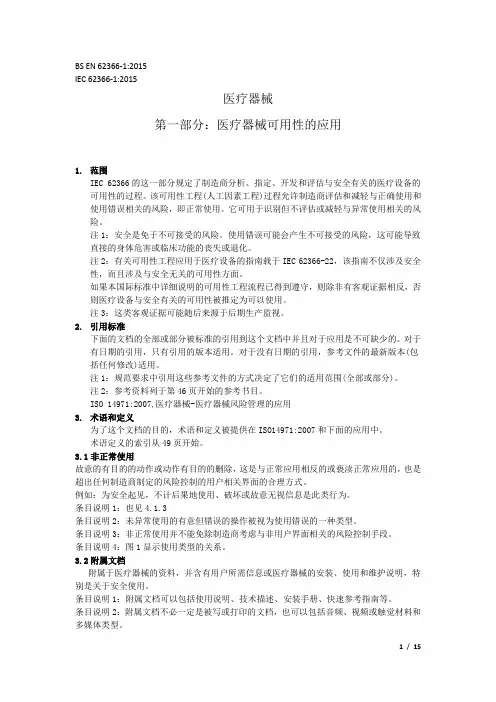
BS EN 62366-1:2015IEC 62366-1:2015医疗器械第一部分:医疗器械可用性的应用1.范围IEC 62366的这一部分规定了制造商分析、指定、开发和评估与安全有关的医疗设备的可用性的过程。
该可用性工程(人工因素工程)过程允许制造商评估和减轻与正确使用和使用错误相关的风险,即正常使用。
它可用于识别但不评估或减轻与异常使用相关的风险。
注1:安全是免于不可接受的风险。
使用错误可能会产生不可接受的风险,这可能导致直接的身体危害或临床功能的丧失或退化。
注2:有关可用性工程应用于医疗设备的指南载于IEC 62366-22,该指南不仅涉及安全性,而且涉及与安全无关的可用性方面。
如果本国际标准中详细说明的可用性工程流程已得到遵守,则除非有客观证据相反,否则医疗设备与安全有关的可用性被推定为可以使用。
注3:这类客观证据可能随后来源于后期生产监视。
2.引用标准下面的文档的全部或部分被标准的引用到这个文档中并且对于应用是不可缺少的。
对于有日期的引用,只有引用的版本适用。
对于没有日期的引用,参考文件的最新版本(包括任何修改)适用。
注1:规范要求中引用这些参考文件的方式决定了它们的适用范围(全部或部分)。
注2:参考资料列于第46页开始的参考书目。
ISO 14971:2007,医疗器械-医疗器械风险管理的应用3.术语和定义为了这个文档的目的,术语和定义被提供在ISO14971:2007和下面的应用中。
术语定义的索引从49页开始。
3.1非正常使用故意的有目的的动作或动作有目的的删除,这是与正常应用相反的或亵渎正常应用的,也是超出任何制造商制定的风险控制的用户相关界面的合理方式。
例如:为安全起见,不计后果地使用、破坏或故意无视信息是此类行为。
条目说明1:也见4.1.3条目说明2:未异常使用的有意但错误的操作被视为使用错误的一种类型。
条目说明3:非正常使用并不能免除制造商考虑与非用户界面相关的风险控制手段。
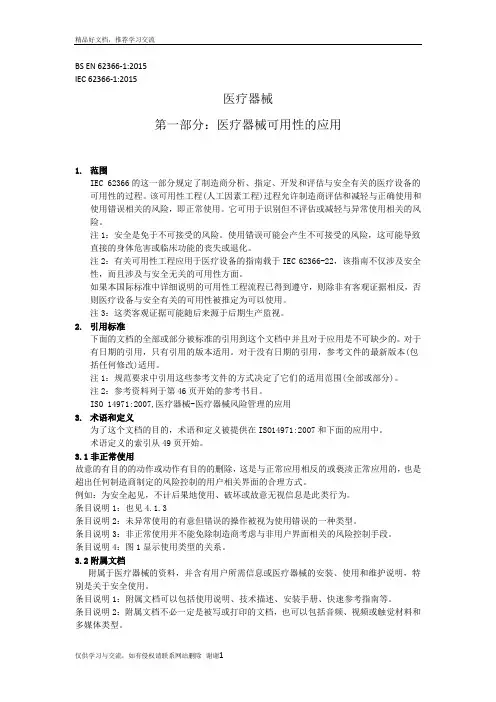
BS EN 62366-1:2015IEC 62366-1:2015医疗器械第一部分:医疗器械可用性的应用1.范围IEC 62366的这一部分规定了制造商分析、指定、开发和评估与安全有关的医疗设备的可用性的过程。
该可用性工程(人工因素工程)过程允许制造商评估和减轻与正确使用和使用错误相关的风险,即正常使用。
它可用于识别但不评估或减轻与异常使用相关的风险。
注1:安全是免于不可接受的风险。
使用错误可能会产生不可接受的风险,这可能导致直接的身体危害或临床功能的丧失或退化。
注2:有关可用性工程应用于医疗设备的指南载于IEC 62366-22,该指南不仅涉及安全性,而且涉及与安全无关的可用性方面。
如果本国际标准中详细说明的可用性工程流程已得到遵守,则除非有客观证据相反,否则医疗设备与安全有关的可用性被推定为可以使用。
注3:这类客观证据可能随后来源于后期生产监视。
2.引用标准下面的文档的全部或部分被标准的引用到这个文档中并且对于应用是不可缺少的。
对于有日期的引用,只有引用的版本适用。
对于没有日期的引用,参考文件的最新版本(包括任何修改)适用。
注1:规范要求中引用这些参考文件的方式决定了它们的适用范围(全部或部分)。
注2:参考资料列于第46页开始的参考书目。
ISO 14971:2007,医疗器械-医疗器械风险管理的应用3.术语和定义为了这个文档的目的,术语和定义被提供在ISO14971:2007和下面的应用中。
术语定义的索引从49页开始。
3.1非正常使用故意的有目的的动作或动作有目的的删除,这是与正常应用相反的或亵渎正常应用的,也是超出任何制造商制定的风险控制的用户相关界面的合理方式。
例如:为安全起见,不计后果地使用、破坏或故意无视信息是此类行为。
条目说明1:也见4.1.3条目说明2:未异常使用的有意但错误的操作被视为使用错误的一种类型。
条目说明3:非正常使用并不能免除制造商考虑与非用户界面相关的风险控制手段。
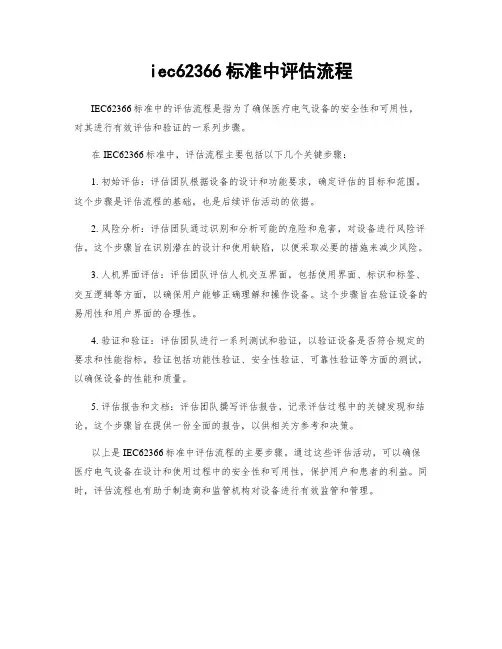
iec62366标准中评估流程
IEC62366标准中的评估流程是指为了确保医疗电气设备的安全性和可用性,对其进行有效评估和验证的一系列步骤。
在IEC62366标准中,评估流程主要包括以下几个关键步骤:
1. 初始评估:评估团队根据设备的设计和功能要求,确定评估的目标和范围。
这个步骤是评估流程的基础,也是后续评估活动的依据。
2. 风险分析:评估团队通过识别和分析可能的危险和危害,对设备进行风险评估。
这个步骤旨在识别潜在的设计和使用缺陷,以便采取必要的措施来减少风险。
3. 人机界面评估:评估团队评估人机交互界面,包括使用界面、标识和标签、交互逻辑等方面,以确保用户能够正确理解和操作设备。
这个步骤旨在验证设备的易用性和用户界面的合理性。
4. 验证和验证:评估团队进行一系列测试和验证,以验证设备是否符合规定的要求和性能指标。
验证包括功能性验证、安全性验证、可靠性验证等方面的测试,以确保设备的性能和质量。
5. 评估报告和文档:评估团队撰写评估报告,记录评估过程中的关键发现和结论。
这个步骤旨在提供一份全面的报告,以供相关方参考和决策。
以上是IEC62366标准中评估流程的主要步骤。
通过这些评估活动,可以确保医疗电气设备在设计和使用过程中的安全性和可用性,保护用户和患者的利益。
同时,评估流程也有助于制造商和监管机构对设备进行有效监管和管理。
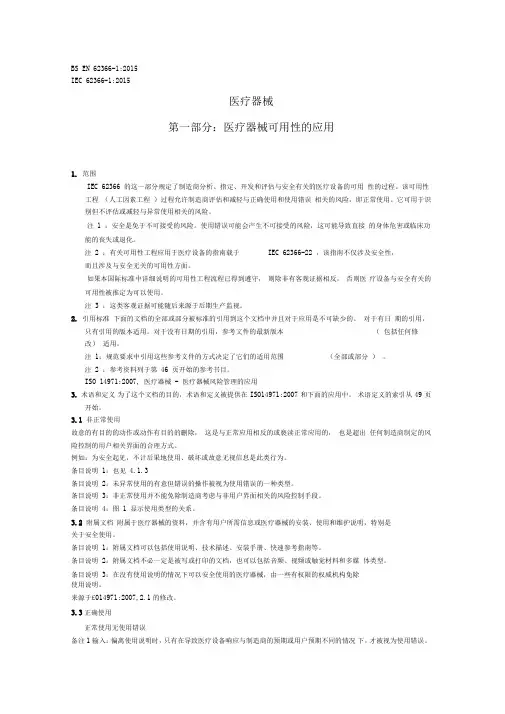
BS EN 62366-1:2015IEC 62366-1:2015医疗器械第一部分:医疗器械可用性的应用1. 范围IEC 62366 的这一部分规定了制造商分析、指定、开发和评估与安全有关的医疗设备的可用性的过程。
该可用性工程(人工因素工程)过程允许制造商评估和减轻与正确使用和使用错误相关的风险,即正常使用。
它可用于识别但不评估或减轻与异常使用相关的风险。
注1 :安全是免于不可接受的风险。
使用错误可能会产生不可接受的风险,这可能导致直接的身体危害或临床功能的丧失或退化。
注2 :有关可用性工程应用于医疗设备的指南载于IEC 62366-22 ,该指南不仅涉及安全性,而且涉及与安全无关的可用性方面。
如果本国际标准中详细说明的可用性工程流程已得到遵守,则除非有客观证据相反,否则医疗设备与安全有关的可用性被推定为可以使用。
注3 :这类客观证据可能随后来源于后期生产监视。
2. 引用标准下面的文档的全部或部分被标准的引用到这个文档中并且对于应用是不可缺少的。
对于有日期的引用,只有引用的版本适用。
对于没有日期的引用,参考文件的最新版本(包括任何修改)适用。
注1:规范要求中引用这些参考文件的方式决定了它们的适用范围(全部或部分)。
注2 :参考资料列于第46 页开始的参考书目。
ISO 14971:2007, 医疗器械- 医疗器械风险管理的应用3. 术语和定义为了这个文档的目的,术语和定义被提供在ISO14971:2007 和下面的应用中。
术语定义的索引从49 页开始。
3.1 非正常使用故意的有目的的动作或动作有目的的删除,这是与正常应用相反的或亵渎正常应用的,也是超出任何制造商制定的风险控制的用户相关界面的合理方式。
例如:为安全起见,不计后果地使用、破坏或故意无视信息是此类行为。
条目说明1:也见4.1.3条目说明2:未异常使用的有意但错误的操作被视为使用错误的一种类型。
条目说明3:非正常使用并不能免除制造商考虑与非用户界面相关的风险控制手段。
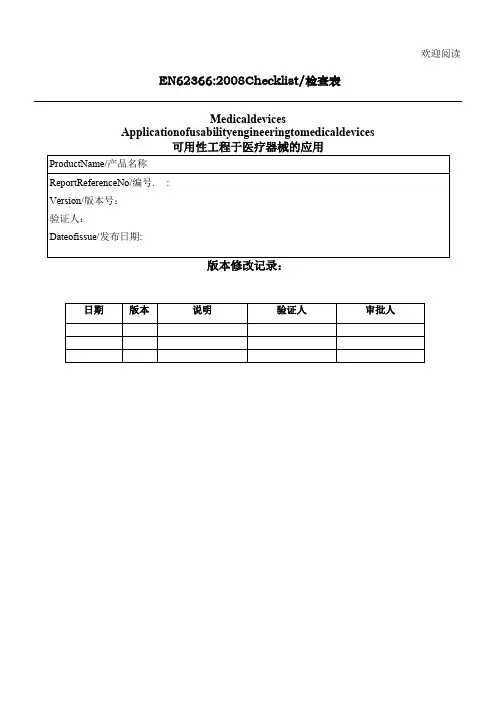
欢迎阅读EN62366:2008Checklist/检查表MedicaldevicesApplicationofusabilityengineeringtomedicaldevices可用性工程于医疗器械的应用ProductName/产品名称ReportReferenceNo/编号. :Version/版本号:验证人:Dateofissue/发布日期:版本修改记录:日期版本说明验证人审批人4 GENERALREQUIREMENTS/总要求4.1 GeneralRequirements/总要求4.1.1 U SABILITY E NGINEERING P ROCESS/可用性工程过程Hasthe MANUFACTURER established,documen tedandmaintaineda USABILITYENGINEERINGPR OCESS toprovideS AFETY forthe PATIENT,USER a ndothersrelatedto USABILITY fortheproduct?制造商是否建立、记录并维持了一个可用性工程过程,以确保患者、用户和其它涉及产品适用性的人的安全? UserManual;Qualitymanual,proceduredocument;ComplianceDoestheP ROCESS address USERINTERA ctionswiththe MEDICALDEVICE accordingtothe ACCOMPANYINGDOCUMENT including,butnotlimitedtotransport,storage,installation,operation,maintenance,repairanddisposal?该过程是否用于解决用户按随机文件与医疗器械的交互,如运输、存储、安装、操作、维护、维修和废弃?UserManual Compliance4.1.2AreR ESIDUAL R ISKS associatedwithU SABILITY ofthe MEDICAL D EVICE presumedtobeacceptable,unlessthereis OBJECTIVEEVIDENCE tothecontraryanddocumented?关系医疗器械可用性的剩余风险是否推定可接受?Riskanalysisreport; Compliance 4.1.3MANUFACTURERSHALL subjecttheinformationf orsafetyusedasa RISKCONTROL tothe USABILIT YENGINEERINGPROCESS(e.g.,warningsorlimit ationofuseinthe ACCOMPANYINGDOCUMENTS, marking,etc.).对于做为风险控制措施的安全信息,制造商应把它纳入可用性工程过程的控制Riskanalysisreport;UserManual;ComplianceDisregardingsuchinformationfor SAFETY isconsideredbeyondanyfurtherreasonablemeansof RISKCONTROL忽视安全信息的行为应被认为是超出风险控制措施的(即非正常使用)Riskanalysisreport Compliance 4.2Theresultsofthe USABILITYENGINEERINGPROCESS arerecordedinthe USABILITYENGINEERINGFILE可用性工程过程的结果记录于可用性工程文档。
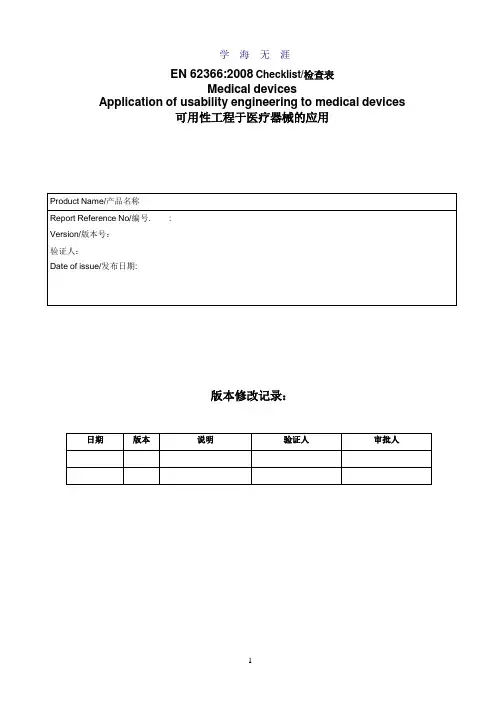
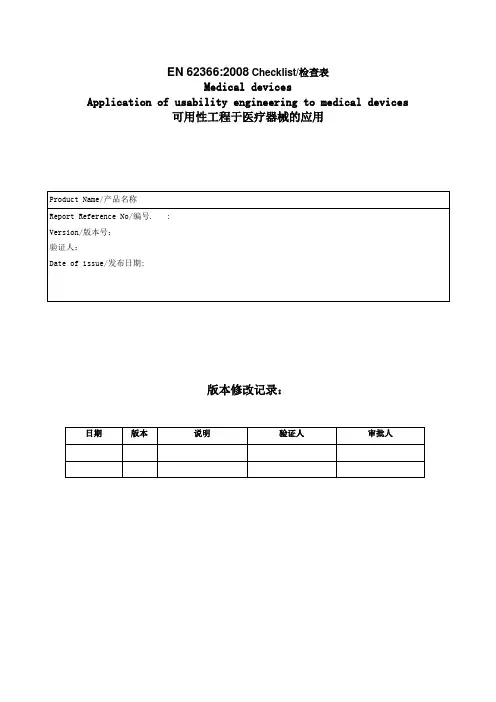
BS EN 62366-1:2015IEC 62366-1:2015医疗器械第一部分:医疗器械可用性的应用1.范围IEC 62366的这一部分规定了制造商分析、指定、开发和评估与安全有关的医疗设备的可用性的过程。
该可用性工程(人工因素工程)过程允许制造商评估和减轻与正确使用和使用错误相关的风险,即正常使用。
它可用于识别但不评估或减轻与异常使用相关的风险。
注1:安全是免于不可接受的风险。
使用错误可能会产生不可接受的风险,这可能导致直接的身体危害或临床功能的丧失或退化。
注2:有关可用性工程应用于医疗设备的指南载于IEC 62366-22,该指南不仅涉及安全性,而且涉及与安全无关的可用性方面。
如果本国际标准中详细说明的可用性工程流程已得到遵守,则除非有客观证据相反,否则医疗设备与安全有关的可用性被推定为可以使用。
注3:这类客观证据可能随后来源于后期生产监视。
2.引用标准下面的文档的全部或部分被标准的引用到这个文档中并且对于应用是不可缺少的。
对于有日期的引用,只有引用的版本适用。
对于没有日期的引用,参考文件的最新版本(包括任何修改)适用。
注1:规范要求中引用这些参考文件的方式决定了它们的适用范围(全部或部分)。
注2:参考资料列于第46页开始的参考书目。
ISO 14971:2007,医疗器械-医疗器械风险管理的应用3.术语和定义为了这个文档的目的,术语和定义被提供在ISO14971:2007和下面的应用中。
术语定义的索引从49页开始。
3.1非正常使用故意的有目的的动作或动作有目的的删除,这是与正常应用相反的或亵渎正常应用的,也是超出任何制造商制定的风险控制的用户相关界面的合理方式。
例如:为安全起见,不计后果地使用、破坏或故意无视信息是此类行为。
条目说明1:也见4.1.3条目说明2:未异常使用的有意但错误的操作被视为使用错误的一种类型。
条目说明3:非正常使用并不能免除制造商考虑与非用户界面相关的风险控制手段。
Usability File MLD 9.05eBS EN 62366:2008Documentation of Compliance1 Inputs to the USABILITY SPECIFICATION1.1 Specification of the INTENDED USE/INTENDED PURPOSE1.1.1 DescriptionThe ACME Bubble Humidifier has been design specifically to be used with Oxygen. The unit can be used in most types of medical environments such as Hospital, Medical Centres, Ambulances and Domestic purposes.The humidifier works by conducting gas down the small internal tube that is submerged in water.The gas passes through the diffuser (sintered metal), which breaks the gas into small bubbles,increasing the surface area. The bubbles float passively to the surface, absorbing water vapour.The humidified gas then flows out through the outlet. The bottle component is moulded inautoclavable HDPE.The Humidifier has been designed to connect to Flowmetering Devices via a 9/16 Connector and that can provide a flow rates from 2 to 6 Lpm with a backpressure of 4 bar.1.1.2 EQUIPMENT application specification1.1.2.1 Medical purposeTo humidify the medical gas flow (Oxygen) to a patient e.g. via attached tubing and facemask.1.1.2.2 PATIENT populationa) Age: newborn to geriatricb) Weight: > 2.5 kgc) Health: not relevantd) Nationality: multiplee) PATIENT state:- PATIENT is not the OPERATOR1.1.2.3 Part of body or type of tissue applied to or interacted withNo direct contact with the patient – though attached tubing and facemask would contact noseand mouth.1.1.2.4 Intended OPERATORTrained medical or paramedical staff who understand how to connect to a flowmeter and the use of humidified oxygen.1.1.2.5 Applicationa) EnvironmentGeneral:- Hospital- Care Home/Hospice- Ambulance- Could be damaged by impact e.g. dropping or collision, then not function.- When functioning is shall keep humidifying the oxygen..Conditions of visibility:- Ambient luminance 100 – 500 lux- Viewing distance 20 cm to 1 metre- Viewing angle: normal to the scale ± 20°Physical:- Working pressure 400 kPa- Operation range 2 to 6 Lpm recommended- Permitted leakage - zero- Normal ambient conditions apply.b) Frequency of use:- Once a year up to 10+ times a dayc) Mobility:- Intended to be fixed to gas supply, which could be on a mobile trolley.1.2 PRIMARY OPERATING FUNCTION1.2.1 Frequently used functionsa) Filling with waterb) Reading scalec) Attaching to/removing from gas supply/flowmeterd) Attaching to patient tubing/facemask.e) Cleaning – can be sterilisedf) Storing1.2.2 Functions related to SAFETYa) Reading scale – especially when water supply exhaustedb) Supplying correct flow for condition/patientc) Cleaningd) Servicing & maintenance1.3 Risk analysis1.3.1 INTENDED USE/INTENDED PURPOSESee 1.11.3.2 USER PROFILESee 1.1.2.41.3.3 Things That could go wrongSources: Literature, Device Alerts, Sales, Healthcare Staff, Risk Analysis etca) During normal use:- Water has run out → level not visibleb) Use Errors:- Not refilling- Applying excessive force/mechanical stress/tampering- Dropping/Impact- Blockage- Leakagec) Environment:- Explosion when exposed to ignition sourced) Patient:- Tamperinge) Reading:- Not reading water level correctlyf) Hygiene:- Cross-contamination1.3.4 Task requirementsa) Clearly recognisable instructions on bottleb) Easily assembled/disassembledc) Readable/legible scaled) Easy cleaning of devicee) Light-weight designf) Easy to service & maintain1.3.5 The context of useSee 1.1.2.51.3.6 Information on HAZARDS known for existing deviceIncluded in 1.3.31.3.7 Resulting HAZARDOUS SITUATIONS and HARMSa) No humidification → improper treatmentb) Too much O2 administered over time – i.e. no CO2 content for breathing responsec) Ineffective therapy e.g. for COPD if Air rather than O2 administered/Hypoxiad) Introducing contaminants to the bodye) Used with patients whose supraglottic airways have been bypassed1.3.8 Preliminary review of the USER INTERFACE conceptNote: This review could be conducted utilizing a combination of cognitive walkthroughs, mock-up testing and early prototype testing.a) Connection into appropriate oxygen flowmeter:- Flowmeters labelled & body/knob colour coded (black – AIR; White – Oxygen) Conclusion: No issuesb) Connecting patient tubing/face mask from flowmeter:- Could supply Air to patient rather than Oxygen or vice versa- Operating outside recommended flow rateConclusion: Training issuec) Preparing use:- Easy to assemble/disassemble- Filling to maximum level with water- Detailed operating function in instructionsConclusion: no issuesd) Reading display:- Font and lines clearly legible- Instructions on bottle)Conclusion: no issuese) Cleaning:- Can be autoclaved- Easy visual identification of contaminated surfaces- Surface finishes smoothConclusion: no issuesf) Removing from gas source/flowmeter- Requires unscrewing from flowmeter- Straight forward procedureConclusion: no issues2 USABILITY SPECIFICATION2.1 Generala) MEDICAL DEVICEBubble Humidifier – H110b) Basis:- Intended use, see 1.1- Possible use errors, see 1.3.3- Hazardous situations or harms related to use, see 1.3.7- Context of useo Patient attaches/un-attaches facemask connected to gas source –flowmeter/humidifier assembly- Preliminary use scenarioso Patient searches for facemask/tubing connected to flowmeter/humidifierassembly by bed Terminal Unit (TU)o Operates attached flowmeter independently2.2 USE SCENARIOSWorst case scenarios to provide a basis for validation with patient = usera) Breathing humidified oxygen in bed:- user/patient = adult- alone in room, not supervised- lying in bed or in chair by bed- operates flowmeter control knob- breathes through attached facemask/tubing- pulls out nasal cannula- ignition source/materials- allows water to run out2.3 USER actions related to PRIMARY OPERATING FUNCTIONSa) Turning attached flowmeter on/offb) Placing connected facemask correctly over nose/mouth or cannula in nosec) Observes water level – reading resultd) Cleaning device after usee) Arranging servicing as necessary (PPM)f) Removing device from gas source/flowmeterg) Storing device correctly when removed (stores/EBME)2.4 USER INTERFACE requirements for the PRIMARY OPERATING FUNCTIONSa) Connection to gas source/flowmeter:- easy connection to flowmeter with one hand- indication on bottle instructions (label) not to use with patients whose supraglottic airways have been bypassedb) Filling with water- easy to fillc) Reading display:- scale and bobbin clearly visible under conditions of visibility, see 1.1.2.5- minimum and maximum level indicated- text on bottle for correct flow rated) Surface and material:- body impact strength 80 kJ/m2 (Notched Charpy)- smooth surfaces for easy cleaninge) Holding part:- bottle height 104mm- bottle width 76mmf) Measuring part:- smooth translucent surface – water level easily visibleg) Cleaning:- can be autoclaved- smooth surfaces for easy accessh) Storage:- should be kept in clean plastic bag (as supplied)i) Accompanying Document – issues to be addressed:- no leakage allowed- no grease or oil to be used- not to be exposed to naked flames or radiant heat source- fill with water to maximum level before connecting to gas supply/flowmeter- do not use if damaged- always carry out Inspection prior to use2.5 USER INTERFACE requirements for those USE SCENARIOS that are most frequent orrelated to SAFETYa) The whole setting and measurement procedure shall be easy to do after reading theaccompanying document- connecting to flowmeter- filling to correct level- reading water level scale- setting attached flowmeter to correct flow rate- cleaning the device after useb) Text: Englishc) Font size 8 pt Arial minimumd) Symbols to be intuitive for intended users2.6 Requirements for determining whether PRIMARY OPERATING FUNCTIONS are easilyrecognisable by USERa) Placing device in correct flowmeter:- no additional requirementsb) Filling:- easy to see scale/levelc) Reading scale:- no additional requirementsd) Cleaning:- no additional requirementse) Turning off:- no additional requirementsf) Removing device from gas source/flowmeter- no additional requirementsg) Storing:- no additional requirements。
医疗器械—将可用性工程应用于医疗器械前言使用医疗器械观察和治疗患者的医疗实践日益增多,由不适当地使用医疗器械所引起的使用错误,也受到人们越来越多地关注。
在许多医疗器械的开发中没有实施可用性工程过程,这些医疗器械在使用上不符合人的直觉习惯,因此难于学习和使用。
随着保健需求的发展,现在包括患者自身在内的用户使用医疗器械的技能较低,而医疗器械却越来越复杂,很少情况下医疗器械用户能够处理难于使用的用户接口。
设计可用性好的医疗器械面临很大挑战,许多组织对此有“同感”,设计具有适当(安全)可用性的用户接口,与用户接口的技术实现相比,需要的技能存在很大不同。
可用性工程过程要达到医疗器械具有合理可用性的目的,这样就可减少使用错误和与使用相关的风险,有些形式的错误使用(但不是全部的错误使用)应由制造商负责控制。
可用性工程过程与风险管理过程的关系见图A.1所示。
本国际标准描述可用性工程过程,并为开发安全的医疗器械提供如何实现和执行可用性工程过程的指南。
该标准不仅可用于制造商开发医疗器械,而且还可用于技术委员会制定特殊医疗器械的标准。
1 范围当可用性与医疗器械安全有关时,本国际标准规定了制造商分析、说明、设计、验证和确认可用性的过程。
可用性工程过程评估和减小由可用性问题引起的风险,这些可用性问题与正常使用下的正确使用和使用错误有关。
本可用性工程过程也可用于鉴别,但不能评估和减小与非正常使用有关的风险。
注:就本标准而言,可用性(见3.17)受到用户接口特性的限制。
如果遵守了本标准中详述的可用性工程过程,并满足了可用性确认计划中的可接受准则(见5.9),那么,如果不是存在相反的客观证据(见4.1.2),和医疗器械有关的剩余风险,即IOS 4971中定义的剩余风险,假定是可以接受的。
本国际标准不适用于和使用医疗器械有关的门诊决策。
2 标准引用下面引用的文档是应用本文档的必备文档。
对于有日期的引用文档,只可使用存档的该日期版本。
BS EN 62366-1:2015IEC 62366-1:2015医疗器械第一部分:医疗器械可用性的应用1.范围IEC 62366的这一部分规定了制造商分析、指定、开发和评估与安全有关的医疗设备的可用性的过程。
该可用性工程(人工因素工程)过程允许制造商评估和减轻与正确使用和使用错误相关的风险,即正常使用。
它可用于识别但不评估或减轻与异常使用相关的风险。
注1:安全是免于不可接受的风险。
使用错误可能会产生不可接受的风险,这可能导致直接的身体危害或临床功能的丧失或退化。
注2:有关可用性工程应用于医疗设备的指南载于IEC 62366-22,该指南不仅涉及安全性,而且涉及与安全无关的可用性方面。
如果本国际标准中详细说明的可用性工程流程已得到遵守,则除非有客观证据相反,否则医疗设备与安全有关的可用性被推定为可以使用。
注3:这类客观证据可能随后来源于后期生产监视。
2.引用标准下面的文档的全部或部分被标准的引用到这个文档中并且对于应用是不可缺少的。
对于有日期的引用,只有引用的版本适用。
对于没有日期的引用,参考文件的最新版本(包括任何修改)适用。
注1:规范要求中引用这些参考文件的方式决定了它们的适用范围(全部或部分)。
注2:参考资料列于第46页开始的参考书目。
ISO 14971:2007,医疗器械-医疗器械风险管理的应用3.术语和定义为了这个文档的目的,术语和定义被提供在ISO14971:2007和下面的应用中。
术语定义的索引从49页开始。
3.1非正常使用故意的有目的的动作或动作有目的的删除,这是与正常应用相反的或亵渎正常应用的,也是超出任何制造商制定的风险控制的用户相关界面的合理方式。
例如:为安全起见,不计后果地使用、破坏或故意无视信息是此类行为。
条目说明1:也见4.1.3条目说明2:未异常使用的有意但错误的操作被视为使用错误的一种类型。
条目说明3:非正常使用并不能免除制造商考虑与非用户界面相关的风险控制手段。
EN 62366:2008 Checklist/检查表Medical devicesApplication of usability engineering to medical devices可用性工程于医疗器械的应用Product Name/产品名称Report Reference No/编号. :Version/版本号:验证人:Date of issue/发布日期:版本修改记录:日期版本说明验证人审批人4 GENERAL REQUIREMENTS/总要求4.1 General Requirements/总要求4.1.1 U SABILITY E NGINEERING P ROCESS/可用性工程过程Has the MANUFACTURER established, documented and maintained a USABILITY ENGINEERING PROCESS to provide S AFETY for the PATIENT, USER and others related to USABILITY for the product?制造商是否建立、记录并维持了一个可用性工程过程,以确保患者、用户和其它涉及产品适用性的人的安全? User Manual;Quality manual, procedure document;ComplianceDoes the P ROCESS address USER INTERA ctions withthe MEDICAL DEVICE according to the ACCOMPANYINGDOCUMENT including, but not limited to transport,storage, installation, operation, maintenance, repairand disposal?该过程是否用于解决用户按随机文件与医疗器械的交互,如运输、存储、安装、操作、维护、维修和废弃?User Manual Compliance4.1.2Are R ESIDUAL R ISKS associated with U SABILITY of theMEDICAL D EVICE presumed to be acceptable, unlessthere is OBJECTIVE EVIDENCE to the contrary anddocumented?关系医疗器械可用性的剩余风险是否推定可接受?Risk analysis report ; Compliance 4.1.3MANUFACTURER SHALL subject the information for safety used as a RISK CONTROL to the USABILITY ENGINEERING PROCESS (e.g., warnings or limitation of use in the ACCOMPANYING DOCUMENTS, marking, etc.).对于做为风险控制措施的安全信息,制造商应把它纳入可用性工程过程的控制Risk analysis report ;User Manual;ComplianceDisregarding such information for SAFETY isconsidered beyond any further reasonable means ofRISK CONTROL忽视安全信息的行为应被认为是超出风险控制措施的(即非正常使用)Risk analysis report Compliance 4.2The results of the USABILITY ENGINEERING PROCESS are recorded in the USABILITY ENGINEERING FILE可用性工程过程的结果记录于可用性工程文档。